Britons are living under the sixth strictest lockdown in the world – and the second harshest in Europe – according to an analysis by the University of Oxford.
Researchers have ranked the pandemic responses of 180 countries on a ‘stringency map’ by looking at how Covid restrictions have affected schools, offices, social gatherings, international travel and freedom to leave home.
Each country was scored on a scale of one to 100, with a higher figure indicating the most severe virus-controlling curbs. The numbers represented an average since the start of the pandemic.
The team put Britain’s Covid restrictions at 86.11 out of 100 by February 17, using the latest available data. Britain’s lockdown was ranked harsher than France (63.89) and the US (68.06), and stricter than Germany’s (83.33).
The analysis comes after Boris Johnson yesterday unveiled his ‘cautious’ lockdown exit strategy which could see life in England return to something close to normal by June at the earliest. The PM’s plan for easing restrictions will be split into four separate steps and will see the country treated as a whole, with no return to a tier system.
Under the first stage, schools in England will reopen from March 8 — though the next stage of loosening won’t be until March 29, when the formal Stay at Home edict is finally dropped. Shops, hairdressers and pubs must remain closed until April 12 at the earliest and international travel is completely off the cards until at least May 17.
Only at June 21 will all legal limits on social contact go, and the remaining elements of the hospitality sector be allowed to open. The Prime Minister stressed that he is being driven by ‘data not dates’ and the timeline is not guaranteed.
The UK is in total lockdown with people only allowed to leave their homes for essential shopping, medical visits or work that can’t be done from home. International travel and socialising in person are banned, and most shops are closed.
Germany’s lockdown is similar but restrictions on social meetings are looser, with people allowed to meet with one individual from another household and work-from-home instructions less strict.
The US is divided, with some states not imposing stay-at-home directives and varying levels of restrictions across the country.
And France is relying on a curfew rather than a lockdown, forcing people to stay home between 6pm and 6am each day. Schools there remain open as usual, unlike in Britain and Germany.
Compared to the UK, the Republic of Ireland was the only place in Europe that had stronger lockdown rules (87.96), the study said. Ireland’s rules are similar to England’s but most construction work has been stopped and click-and-collect shopping services are not allowed.
Worldwide, Cuba (90.74), Eritrea (89.81), Honduras (87.96) and Lebanon (87.04) also had tougher measures, and Peru had the same score as the UK. The Coronavirus Response Tracker shows the differences between countries in an interactive map.

This map shows how lockdown rules differed between countries on February 17, with darker colours indicating harsher rules. Light blue shows a score up to 39.9 out of 100 – the least oppressive measures -, and dark blue shows from 40 to 59.9. Black shows between 60 and 69.9, purple shows between 70 to 79.9. The harshest rules are indicated by pink and red, showing countries scoring more than 80 in the analysis

WHICH COUNTRIES HAD THE MOST SEVERE LOCKDOWNS?
Country
Cuba
Eritrea
Ireland
Honduras
Lebanon
Britain
Peru
—
Germany
US
France
Score
90.74
89.81
87.96
87.96
87.04
86.11
86.11
—
83.33
68.06
63.89
Source: Calculated by the University of Oxford’s Coronavirus Response Tracker. It is for restrictions as of February 17, the latest available.
Advertisement
Britain’s lockdown was ratcheted up over Christmas with the discovery of the Kent variant, which is believed to spread significantly faster than older versions of the virus.
The variant – which was first detected in the UK and now makes up a majority of cases there – made controls that had worked against the old virus less effective, forcing ministers to impose tighter curbs.
The Blavatnik School at Oxford University compiled the response tracker to compare shutdown measures imposed in different countries.
They used 19 indicators for the scores – which also included closing public transport, restrictions on internal movement and income support.
Restrictions were put into categories and each was given a number on a scale depending on how strict it was, then these were entered into a complex mathematical equation to produce a total score out of 100, with stricter rules producing higher numbers.
Data on restrictions is collected from public sources by a team of more than a hundred students and staff at Oxford University.
The project’s lead researcher Thomas Hale told the Telegraph the UK’s current high score was triggered by school closures.
‘The UK has done a lot in this third lockdown and introduced some stringent measures,’ he said.
‘One of the main factors is the school closures, whereas most of Europe have tried to keep schools open.
‘It would make sense for the UK to have a higher score as it has been hard hit and there have been stringent measures.
‘If you take France, they have tried to make things work with a curfew rather than a blanket stay-at-home message.
‘The French also have a wider definition of what is essential and no restrictions on being able to move around, whereas you obviously can’t go to other parts of the country here.’
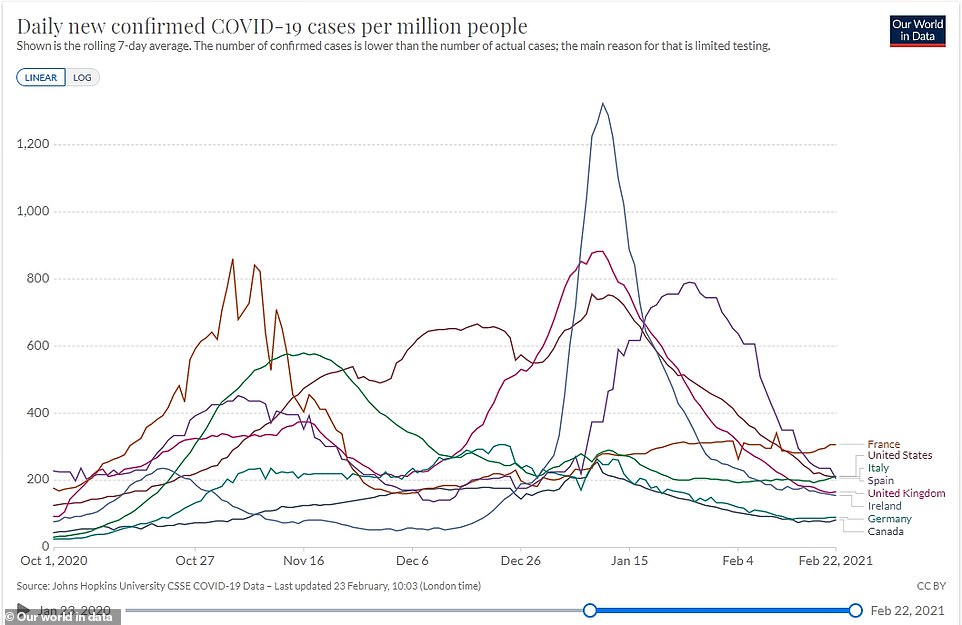
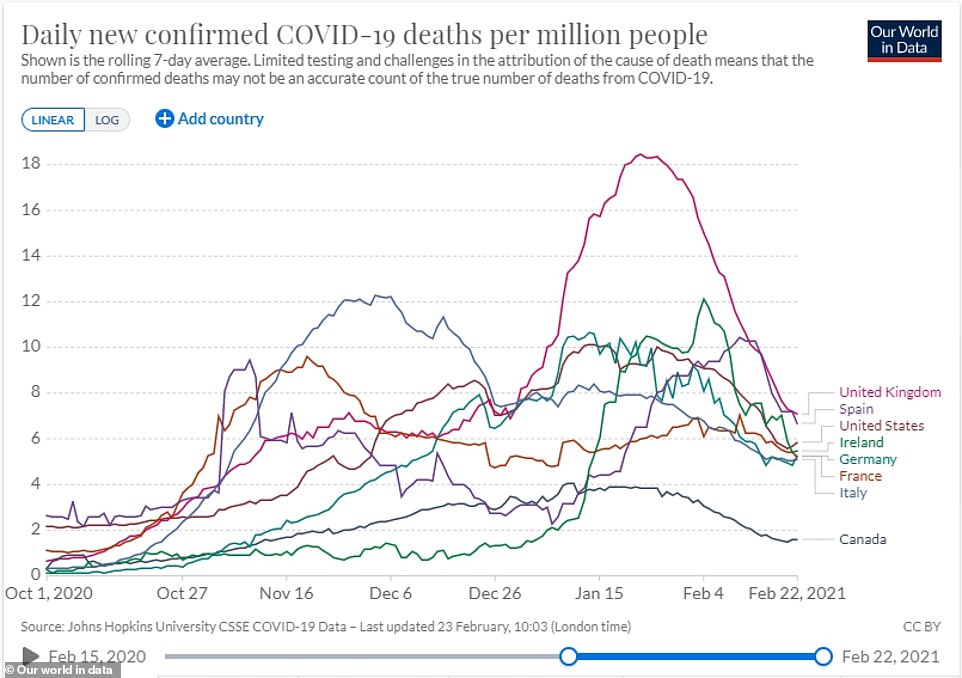
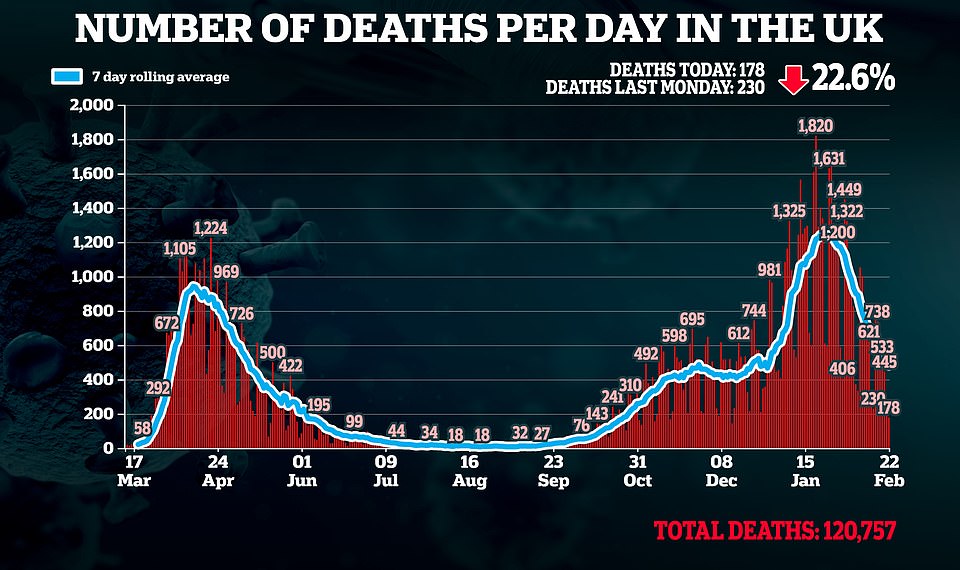
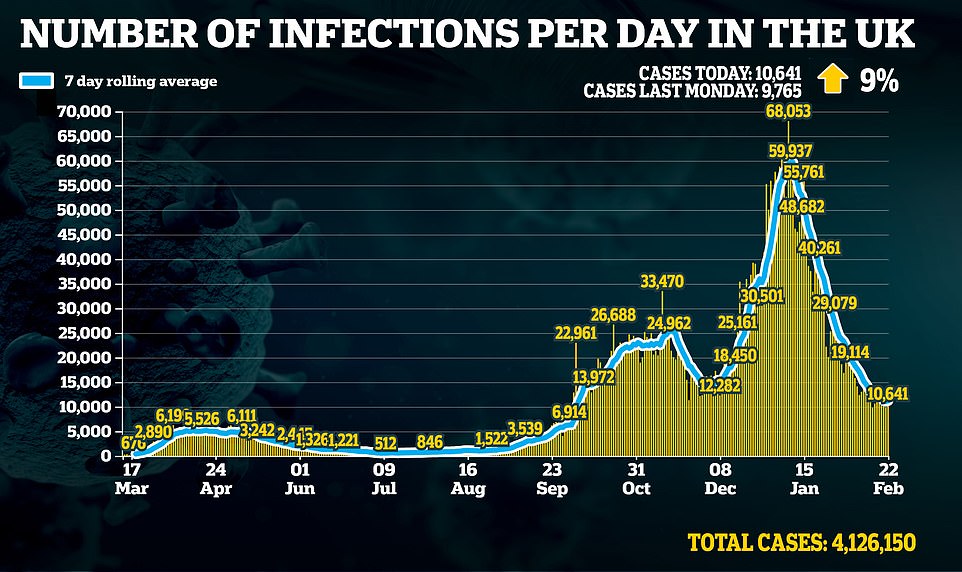
Boris slaps down Neil Ferguson and Tories pushing for an earlier end to lockdown
Boris Johnson today hit back at Tories and scientists suggesting lockdown could ease faster – as Wales and Scotland warned his roadmap might be too quick.
The PM said he was being ‘sensible and prudent’ with his four-stage plan after attacks on the approach from both sides.
‘Some people will say we’re going to be going too fast, some people will say we’re going too slow,’ he said on a visit to a school in South London.
Mr Johnson refused to guarantee that all restrictions will definitely be lifted by June 21 as scheduled, but insisted he was ‘hopeful’ it can happen.
The intervention came after Matt Hancock slapped down Professor Neil Ferguson for suggesting the government’s blueprint for England could be speeded up if things go well.
Tories and business have been voicing disquiet about the ultra-cautious approach being taken by ministers, even though the vaccination drive has been surging ahead.
Schools will return on March 8, but there will be almost no further loosening of the draconian curbs before Easter. There will be a five week gap between each of the four main stages of the plan, with scientists having won the argument in government that time is needed to assess the impact.
The PM has been boosted by snap polls showing the public largely backs his stance, with 46 per cent telling YouGov it is about right – and around a fifth suggesting it is too fast.
Welsh government experts said today that Mr Johnson’s timeline is ‘risky’ and the outbreak could spiral out of control again, while Nicola Sturgeon is expected to unveil her own more cautious exit strategy this afternoon.
Prof Ferguson – whose grim modelling triggered the initial lockdown last year – sounded a bright note on Times Radio last night.
‘Hopefully what we’ll see when each step happens is a very limited resurgence of infections. In which case, there’s a chance we can accelerate the schedule,’ he said.
Advertisement
It comes after the PM yesterday unveiled his four-step roadmap to easing lockdown.
Scotland and Wales yesterday allowed children up to the age of eight to return to school, and England is set to bring all pupils back to the classroom on March 8.
Announcing his blueprint back to normality, the Prime Minister warned they would be led by the ‘data not dates’, but that he hopes to relax restrictions in five-week stages.
Mr Johnson’s plan will be split into four separate steps and will see the country treated as a whole, with no return to a tier system
The loosening of England’s third national lockdown, imposed amid a winter outbreak of coronavirus in January, will begin on March 8 when all schools across the country will return.
A different set of rules are then due to be lifted every five weeks to allow four weeks to measure the impact of changes and to give a further week’s notice before the next step comes into force.
However, the Government has stressed that dates could change depending on the scale of the coronavirus outbreak.
In his statement to the Commons, Mr Johnson said there are four tests for reopening the country: the success of the vaccine roll-out, evidence that Covid jabs are reducing hospitalisations, infection rates not putting ‘unsustainable pressure’ on the NHS, and whether the risks are ‘fundamentally changed’ by new variants.
The changes must be gradual, Mr Johnson said, because a third wave of the virus is inevitable and it must be controlled because vaccines aren’t perfect.
Speaking from a Downing Street press conference last night Mr Johnson said: ‘We’re now travelling on a one-way road to freedom and we can begin safely to restart our lives, and do it with confidence.
‘And I want to be frank about exactly what that means and the trade-offs involved.
The vaccines reduce the danger of Covid, they save lives and they keep people out of hospital. But no vaccine against any disease has ever been 100 per cent effective.
‘So, whenever we ease the lockdown – whether it’s today or in six or nine months – we’ve got to be realistic and accept that there will be more infections, more hospitalisations and therefore, sadly, more deaths, just as there are every year with flu.
‘Even if we sustained the lockdown indefinitely, which would itself cost lives and do immeasurable harm to our children, we would not be able to eradicate this disease.
‘And that’s why it’s right, gradually, to replace the protection afforded by lockdown, with the protection of the vaccines. And our approach is to move with the utmost care.’
Boris Johnson’s lockdown exit strategy in full: All schools back on March 8, two households meeting outdoors from March 29, non-essential shops, pubs and hairdressers open from April 12 and back to normal on June 21
Prime Minister Boris Johnson yesterday unveiled his ‘cautious’ lockdown exit strategy which could see life in England return to something close to normal by June at the earliest.
Mr Johnson’s plan for easing restrictions will be split into four separate steps and will see the country treated as a whole, with no return to a tier system.
The loosening of England’s third national lockdown, imposed amid a winter outbreak of coronavirus in January, will begin on March 8 when all schools across the country will return.
Rules are then due to be lifted every five weeks to allow four weeks to measure the impact of changes and to give a further week’s notice before the next step comes into force.
However, the Government has stressed that the dates set out in the roadmap are ‘not before dates’ and that they could change depending on the scale of the coronavirus outbreak.
In his statement to the Commons, Mr Johnson said there are four tests for reopening the country: the success of the vaccine roll-out, evidence that Covid jabs are reducing hospitalisations, infection rates not putting ‘unsustainable pressure’ on the NHS, and whether the risks are ‘fundamentally changed’ by new variants.
Below is a breakdown of the measures outlined in each step:

In his statement to the Commons, Mr Johnson explained there are four tests for reopening the country
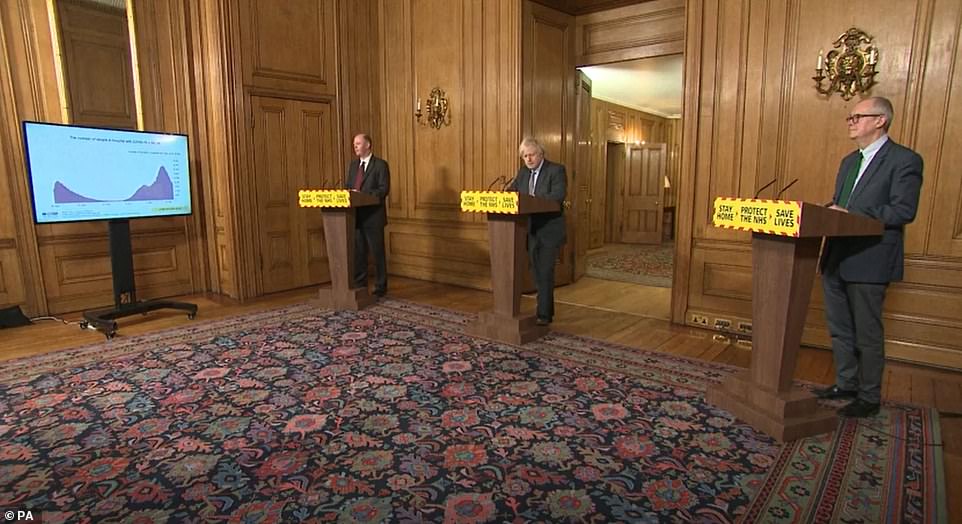
Chief Medical Officer Chris Whitty, Prime Minister Boris Johnson and Chief Scientific Adviser Sir Patrick Vallance
Step One Part One: March 8
SCHOOLS: From March 8, all pupils and students will return to schools and colleges across England.
University students who require practical teaching to complete their studies will also be allowed to return., those who do not need practical teaching will still be banned from campuses with ministers due to conduct a review by the end of the Easter holidays on the options for their return.
So-called wrap-around childcare (including childminders) will also be allowed to resume for all children where it is needed to enable parents or carers to work, seek work, attend education, seek medical care or attend a support group.
Vulnerable children can attend these settings regardless of circumstance. Under-18 sport can take place at school as part of educational provision, or as part of wraparound care, but should not otherwise take place at this time.
In its roadmap, the Government called returning face-to-face education in schools and colleges a ‘national priority’. It also said there was ‘clear evidence’ that ‘time out of education can be detrimental to children’s future prospects and earning potential, with implications also for long-term productivity’.
The Government also recommends that the use of face coverings in Higher Education, Further Education and secondary schools is extended for a limited period to all indoor environments – including classrooms – unless 2m social distancing can be maintained.
CARE HOMES: Meanwhile, every care home resident in England will be able to nominate a single named visitor who can come in for a regular visit.
The visitor will have to take a rapid lateral flow test every time they visit, wear PPE and keep physical contact to a minimum.
The Government’s stay at home order will remain in place, with travel for non-essential purposes still banned.
OTHER: People will be allowed to meet one other person outside for recreation, for example, to have a picnic or to meet for coffee.


Year 8 pupils at Moor End Academy in Huddersfield, Northern England in September 2020
Step One Part Two: March 29
OUTDOOR GATHERINGS AND SPORTS: From March 29, outdoor gatherings of up to six people or a larger group from up to two households will be allowed in private gardens as well as public spaces like parks.
The Government states: ‘Applying either limit provides greater flexibility, recognising the different situations faced by families and individuals; two households will be more helpful for families, while the Rule of Six is likely to help people in different households to reunite outdoors, including those living alone or in shared accommodation.
‘Those eligible to form a support bubble will still be able to do so, enabling close contact for many of those in most need of support, and will continue to be counted as part of the same household.’
Outdoor sports facilities to reopen, such as tennis and basketball courts, and swimming pools, will also ber permitted, broadening the options for outdoor exercise and recreation.
These facilities can be used by people in line with the wider social contact limits. Formally organised outdoor sports – for adults and under 18s – can also restart and will not be subject to the gatherings limits, but should be compliant with guidance issued by national governing bodies.
STAY AT HOME TO BE SCRAPPED: It is at this point that the Government’s stay at home guidance will end, to be replaced by ministers encouraging people to ‘stay local’.
However, the Government is not expected to define exactly what constitutes local, instead choosing to rely on people using their common sense to decide on journeys.
Its roadmap also states: ‘Many of the lockdown restrictions, however, will remain in place. Unless an exemption already applies, it will not be possible to meet people from other households indoors and many business premises will remain shut.
‘Guidance will set out that people should continue to work from home where they can. People should continue to minimise travel wherever possible, and should not be staying away from home overnight at this stage.’
WORK FROM HOME: People will still be told to work from home wherever possible while international travel will still be banned unless it is for essential purposes.
As before, people can leave home for work if they cannot work from home and to escape illness, injury or risk of harm, including domestic abuse.
ELECTIONS: The roadmap explains that Covid-secure council, mayoral and police and crime commissioner elections will go ahead on May 6 in England and Wales.
The Government plans to amend the coronavirus regulations ‘to enable a broader range of campaign-related activity from March 8, but it is essential that this still takes place in a Covid-Secure way, in line with guidance and the law’.
The Scottish and Welsh Governments are responsible for their elections with the exception of the Police and Crime Commissioner Elections in Wales.
The Government’s ‘socio-economic analysis’ of Step 1: How education and physical and mental health have all deteriorated during the coronavirus lockdowns
SCHOOL CLOSURES
The Government’s roadmap admits that school closures and restrictions on face-to-face education has had ‘significant and adverse impacts on children’s learning, development and mental health’.
By February 2021 half term, studies suggest the total loss in face-to-face learning could amount to around half a school year, with two thirds of a normal year lost if school reopening were to be delayed to after Easter.
The roadmap states that as well as benefiting students directly, parents will no longer have to balance childcare and working from home: ‘Around 53 per cent of parents report a reduced ability to work as a result of school closures; this is more acutely felt by parents of early years and primary aged children.’
SPORTS, AMUSEMENT AND RECREATIONAL ACTIVITIES
Sports, amusement and recreational activities were worth an estimated £12.8billion in the UK in 2019 (£11billion in England), providing around 565,000 jobs (484,000 in England), the roadmap says.
The Government believes that the easing of measures could enable some of these activities to return and take advantage of the spring/summer season and recover lost revenues.
These businesses are particularly important employers for young people, with 37 per cent of their workforce between 16 to 24 years old (compared to a national average of 11 per cent), the Government added.
PHYSICAL AND MENTAL HEALTH
The roadmap admits that lockdowns have had a massive effect on the physical and mental health of ‘large parts of the population, in particular children and those living alone’.
The Government believes that opening outdoor sports settings will ‘reduce individuals’ risk of major illnesses, such as heart disease, stroke, type 2 diabetes and cancer by up to 50 per cent and lower risk of early death by up to 30 per cent’.
Physical activity is also known to help with improving mental health through better sleep, happier moods, and managing stress, anxiety or intrusive and ‘racing’ thoughts, the roadmap added.
It also recorded how restrictions on socialising have had an adverse impact on people’s wellbeing and mental health with nearly half of adults (49 per cent) reporting boredom, loneliness, anxiety or stress arising due to the pandemic.
Advertisement 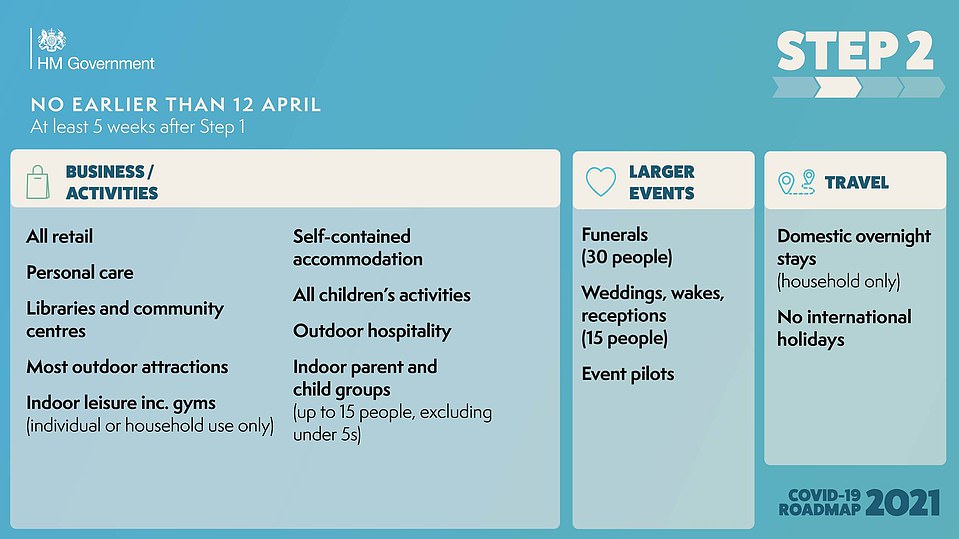
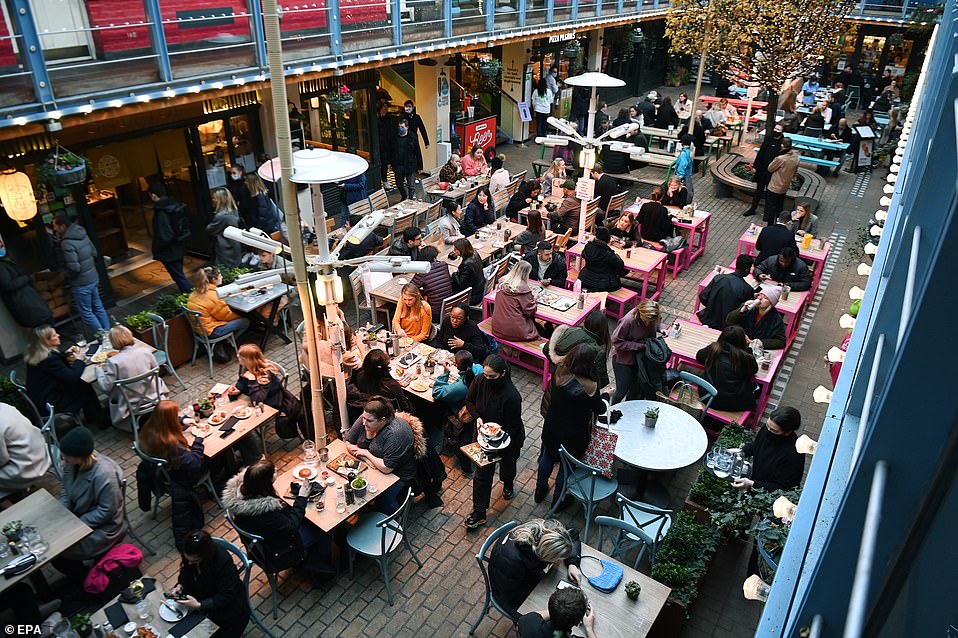
Customers dine in Soho in London, Britain, December 15, 2020
Step Two: ‘No earlier than’ April 12
The Government’s roadmap explains that Step Two will take place no earlier than April 12, around four weeks after Step One has been implemented.
The document states that Step Two will reopen some sections of our indoor economy and more outdoor settings, restoring jobs and livelihoods and enabling people to access some activities and services.
However, social contact rules in England will not change further at this point and outdoor gatherings must still be limited to six people or two households as in Step One.
However, if Step Two is delayed, ‘subsequent steps will need to be pushed back in order to maintain the necessary five week period to assess the impact of each step and provide notice’.
HAIRDRESSERS AND NON-ESSENTIAL HOSPITALITY: Non-essential retail will reopen no earlier than April 12 as well as personal care businesses like hairdressers, barbers and nail salons.
Public buildings like libraries, museums and art galleries will be allowed to welcome back customers.
Meanwhile, hospitality venues and outdoor attractions like theme parks will be given the green light to reopen in some form.
However, there will still be rules on household mixing: Essentially any activity which involves being indoors will be restricted to members of the same household.
GYMS AND LEISURE: Gyms and swimming pools will also reopen from at the earliest April 12 but only on the basis that people go on their own or with members of their own household.
PUBS AND RESTAURANTS: Pubs and restaurants will be able to reopen from April 12 at the earliest, but at this point they will only be able to have customers outdoors.
Any visits to a pub or restaurant will have to comply with the rules on social contact, so no more than two households or the rule of six.
The Government will not be bringing back the old requirement for people to order a substantial meal with alcohol while the old 10pm curfew will also be ditched.
All customers at hospitality venues will have to be seated when they order food or drink, with ordering at the bar prohibited.
CAMPSITES AND HOLIDAYS: Campsites and holiday lets where indoor facilities are not shared with other households can also reopen but trips must be restricted to a single household.
WEDDINGS AND FUNERALS: Funerals will be allowed to continue with up to 30 people, while the rules on wedding receptions will be eased to allow the number of guests to increase from six to 15.
LARGE CROWDS: The Government will also launch pilot programmes in April to see how events with large crowds and reduced social distancing could work.
INTERNATIONAL TRAVEL: A new task force looking at how to increase inbound and outbound international travel, while also protecting against importing coronavirus variants, will report on April 12.
The expectation is that international travel will not resume until May 17 at the very earliest.
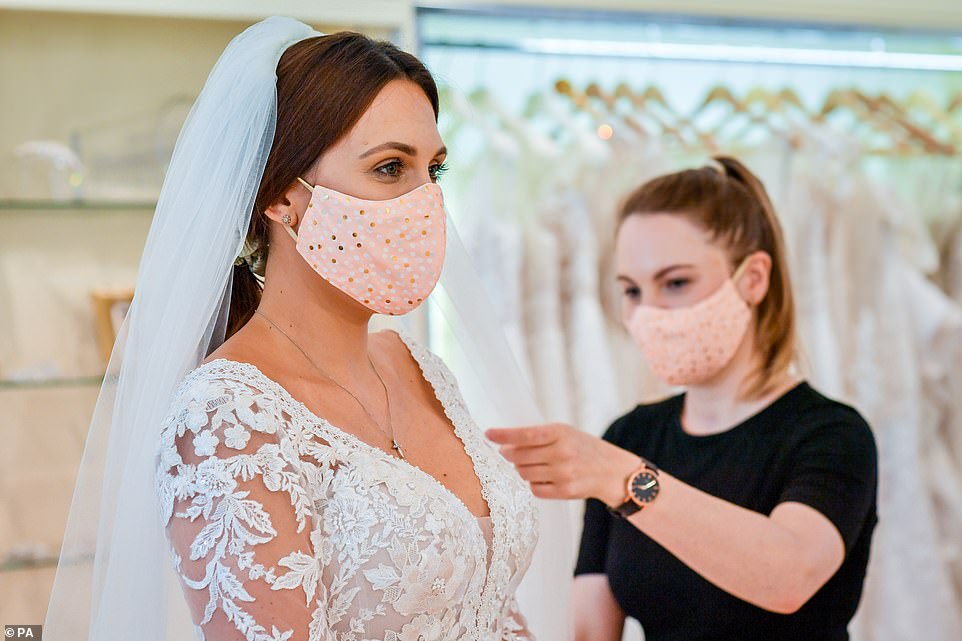
Face coverings are worn by bride to be Jessica Letheren and bridal consultant Felicity Gray during a dress fitting appointment at Allison Jayne Bridalwear in Clifton, Bristol, on June 25, 2020
The Government’s ‘socio-economic analysis of Step Two’: How lockdowns have devastated UK plc
FURLOUGH
The roadmap states that the closure of non-essential retail during the pandemic – estimated to be worth £44.6billion of Gross Value Added (GVA) in the UK in 2019, employing around 1.2 million people. – has led to a high take-up of the furlough scheme in the wider wholesale and retail sector.
Use of furlough peaked at 1.9 million in April, and 740,000 at the end of November in the UK.
People from ethnic minorities are overrepresented in this sector, making up 16 per cent of workers, as are young people (35 per cent are 16 to 24). Women also make up a greater proportion of employees (66 per cent compared to 47 per cent nationally).
HOSPITALITY
Hospitality is a core part of the UK’s economy, the roadmap states. The whole Accommodation and Food Services sector was estimated to be worth £57.6billion in the UK 2019 (£48.5billion in England), providing jobs for 2.5 million people (2.1 million in England).
This sector has been one of the hardest hit by the pandemic: GVA output fell by 91 per cent in April and 89 per cent in May 2020, compared to February 2020.
The November restrictions also hit the hospitality sector hard, with GVA falling back to 65 per cent below its pre-pandemic level.
This sector has also had large parts of its workforce on furlough: in the first wave 1.6 million jobs were furloughed at its peak; at the end of November 1.1 million jobs in this sector were on furlough.
Between 25 January and 7 February, 62 per cent of businesses in accommodation and food services had paused trading.
PERSONAL CARE ACTIVITIES
Personal care activities accounted for £21.1billion in the UK in 2019 (£18.9billion in England), providing 566,000 jobs (507,000 in England).
Women are significantly overrepresented in this sector, making up 85 per cent of the workforce.
The Government has admitted in its document that public buildings and spaces ‘play a vital role in the economic and social life of communities’.
The roadmap also states: ‘Libraries, and other community centres, are valuable and safe places, often to the most vulnerable groups in society.
‘They provide both services to local communities and spaces to socialise. All public spaces have important benefits that help create local attachments and sense of belonging to a community.’
Advertisement 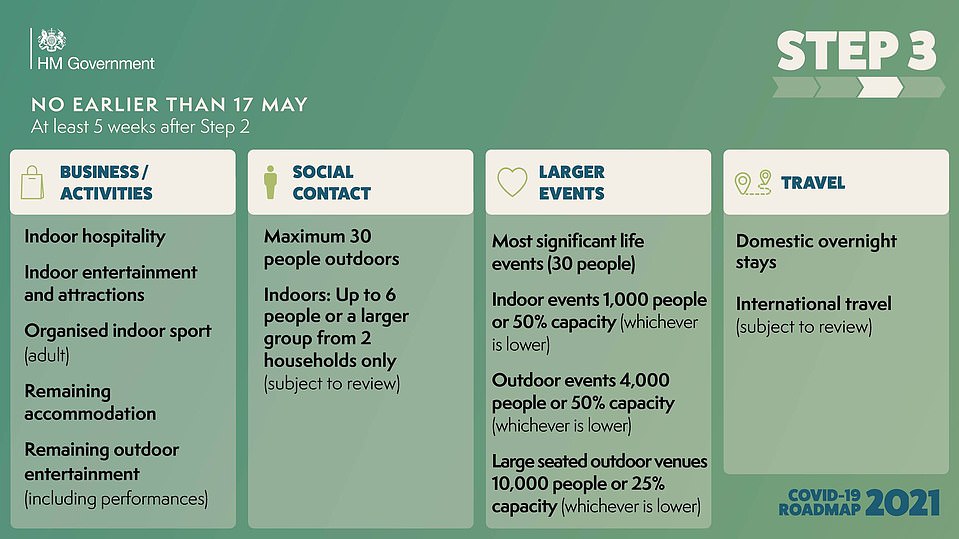

Women pose for a photo at an outdoor dining area on Northcote Road in Battersea, London on September 13, 2020
Step Three: ‘No earlier than’ May 17
Again, Step Three will take place no earlier than 17 May, and at least five weeks after Step Two, following a further review of the data and the four tests.
Again, the Government will announce one week in advance whether restrictions will be eased as planned.
In Step Three, all but the most high-risk sectors will be able to reopen. In all sectors, Covid-secure guidance will remain in place and premises must not cater for groups larger than the legal limits, the roadmap states.
TWO HOMES AND RULE OF SIX: The two household and rule of six requirements for outdoor gatherings will be ditched but gatherings of more than 30 people in places like parks will still be illegal.
Crucially, mixing indoors will be allowed again. The rule of six or a larger group from up to two households will be allowed to meet.
However, this will be kept under review by ministers to see if rules could be relaxed still further.
PUBS AND RESTAURANTS: This is also the point at which pubs and restaurants and other hospitality venues will be able to open indoors, with the rule of six and two household limit in place. Larger groups will be able to meet outdoors at a pub.
Entertainment venues like cinemas and children’s play areas will be able to reopen, as will hotels and B&Bs. Indoor adult sports groups and exercise classes can also reopen.
The Government’s ‘socio-economic analysis’ of Step Three: How arts and entertainment have been decimated by the lockdowns
ARTS AND ENTERTAINMENT
The Government’s roadmap admits that the arts, entertainment and recreation sector (excluding sports, amusement and recreation) has been hit very hard by the pandemic.
Pre-Covid-19, this sector was worth £18.3billion GVA UK wide (£15.5billion in England) and had 473,000 jobs (400,000 in England).
GVA output in the arts, entertainment and recreation sector as a whole compared to February fell by 46 per cent in April, and subsequently to 33 per cent in November; in no month since March has output been above 77 per cent of pre-pandemic levels.
The sector as a whole has also had a high take-up of the furlough scheme, with 455,000 furloughed at peak in spring, and 293,000 furloughed at the end of November.
Between 25 January and 7 February, 44 per cent of businesses in the arts, entertainment and recreation sector have paused trading.
Reopening these sectors can allow these businesses to recover revenues and bring back employees.
SOCIAL CONTACT
The Government also revealed that the relaxation of social contact rules is ‘likely to have a positive impact on wellbeing as people will be able to socialise and meet friends and family indoors for the first time in several months’.
‘Restrictions on social contact have had adverse mental health and wellbeing impacts’, the Government admitted.
Advertisement 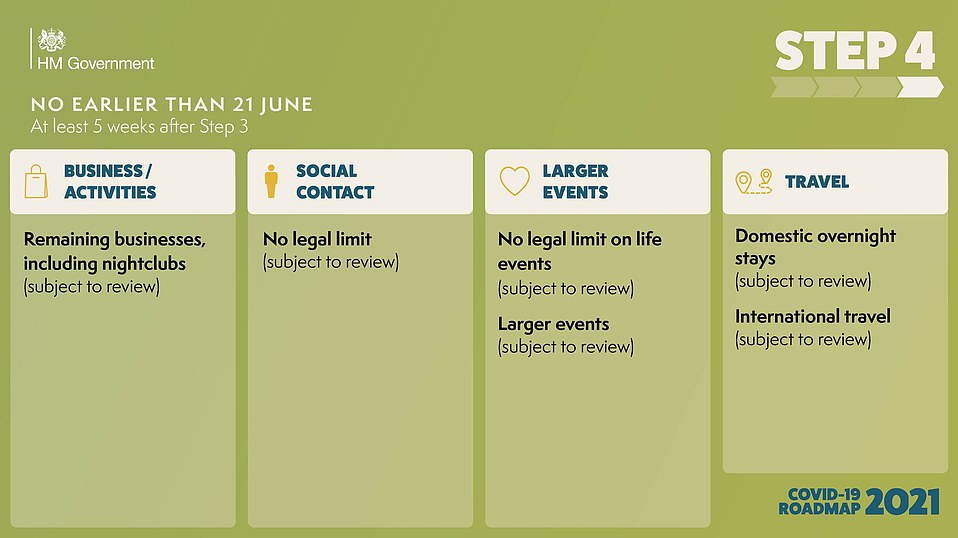
SPORTS AND PERFORMANCE VENUES: Changes will also be made to sporting and performance events in indoor venues with a capacity of 1,000 people or half full, whichever is lower, will be allowed, while outdoors a capacity of 4,000 people will be allowed or half full, whichever is lower.
In the biggest outdoor stadiums, up to 10,000 fans will be allowed to attend matches or a quarter of capacity, whichever is lower.
WEDDINGS AND FUNERALS: Rules on weddings will be eased further, with up to 30 people allowed to attend receptions as well as other life events including christenings.
COVID PASSPORTS: A Government review on whether to introduce vaccine passports or ‘Covid Status Certification’ documents is due to report before Step Four.
It will look at whether the documents, which could show if someone has been tested or if they have had a jab, could help to reopen the economy and make life easier.
MASKS AND SOCIAL DISTANCING: A review of social distancing measures is also due to conclude before Step Four.
It will look at issues like working from home, the wearing of face masks and the one metre plus rule and decide how long such measures will need to be retained.
Step Four: ‘No earlier than’ June 21
REMAINING RESTRICTIONS: This is the point at which the Government is hoping to lift all of the remaining restrictions on social contact and to reopen sectors of the economy which have not already returned and which could not resume last summer.
For example, this is when night clubs could be allowed to fully reopen while restrictions on large events and performances could also be lifted.
Mass-testing could be used to to reduce the risk of infection at those settings.
The Government will also make a decision on whether all restrictions can be removed on weddings and other life events.
However…
The Government has said that measures may be required even after all adults have been offered a vaccine, because neither coverage nor effectiveness of the vaccine will be 100 per cent.
As a result, a significant proportion of the population will remain vulnerable to infection, some of whom will also be vulnerable to severe disease and death.
This is reflected in the modelling of different scenarios for unlocking restrictions, which shows that the risk of further cases, hospitalisations and deaths remains after the adult population has been vaccinated, though modellers advise there is considerable uncertainty in these figures.
Source link : https://www.dailymail.co.uk/news/article-9290029/Britains-coronavirus-lockdown-one-toughest-WORLD-study-claims.html











